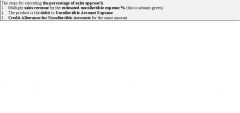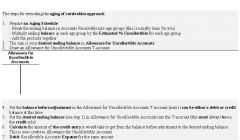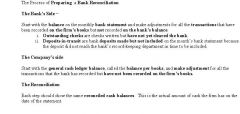![]()
![]()
![]()
Use LEFT and RIGHT arrow keys to navigate between flashcards;
Use UP and DOWN arrow keys to flip the card;
H to show hint;
A reads text to speech;
48 Cards in this Set
- Front
- Back
|
What are the three steps in the percentage of sale approach to calculating bad debt expense?
|

See above
|
|
|
How do you use the aging of accounts receivable approach?
|

See above
|
|
|
What are the steps in preparing a bank reconciliation?
|

See above
|
|
|
What is an accounts receivable?
|
Accounts receivable is a current asset that arises from sales on credit of goods and services to a customer; the total customers owe a firm. It is also called trade receivables.
|
|
|
What Accounts Receivable amount is shown on the balance sheet?
|
When a firm reports Accounts Receivable on its balance sheet, the amount must be what the firm expects to collect. This amount is called net realizable value.
|
|
|
What is the allowance method of accounting for bad debts?
|
The allowance method is a method of accounting for bad debts in which the amount of uncollectible accounts is estimated at the end of each accounting period.
|
|
|
What is bad debt expense?
|
Bad debt expense is the expense to record uncollectible accounts receivable
|
|
|
Describe the percentage of sales method for accounting for bad debts.
|
Percentage of sales method. This method focuses on the income statement and the amount of the current period’s sales for which collection will not be made.
|
|
|
Describe the Aging of Accounts Receivalbe method of accounting for bad debts.
|
Aging of account receivable method. This method focuses on the balance sheet. It calculates the total amount needed to get the balance in the Allowance for Uncollectible Accounts to the amount that needs to be subtracted from Accounts Receivable to make it equal to net realizable value.
|
|
|
What is an aging schedule?
|
An aging schedule is an analyses of the amounts owed to a firm by the length of time they have been outstanding.
|
|
|
Describe the driect write-off method of accounting for bad debts.
|
The direct write-off method is a method of accounting for bad debts in which they are written off – booked as bad debt expense – in the period in which they are identified as uncollectible. This method does not follow GAAP.
|
|
|
What is a promissory note?
|
A promissory note is a written promise to pay a specific amount of money on demand or at a particular time.
|
|
|
Who is the maker of a promissory note?
|
Maker – the person or firm making the promise to pay a promissory note.
|
|
|
Who is the payee of a promissory note?
|
Payee – the person or firm receiving the payment from a promissory note.
|
|
|
How is a notes receivable created?
|
Notes receivable are often created when a firm will renegotiate an overdue account by allowing a customer to sign a promissory note giving the customer more time to pay and charging interest on the loan.
|
|
|
What is the formular for calculating interest?
|
The formula for calculating interest is: principal x interest rate x time.
|
|
|
What is a key control of cash?
|
A key control of cash is segregation of duties.
|
|
|
What is a bank statement?
|
A bank statement is a summary of the activity in a bank account sent each month to the account owner.
|
|
|
What are the terms used for assets that will last for more than one accounting period?
|
Long-term assets, fixed assets, long-lived assets, and operating assets are used to describe assets that will be used for more than one accounting period.
|
|
|
What is a tangible asset?
|
Tangible assets – assets with physical substance – they can be seen and touched.
|
|
|
What is an intangible asset?
|
Intangible assets – rights, privileges, or benefits that result from owning long-lived assets that do not have physical substance.
|
|
|
Describe a basket purchase.
|
A basket purchase is when two or more assets are acquired for a single price. A separate cost must be calculated for each asset using a relative fair market method. It is based on the assets’ individual market values.
|
|
|
What does the term capitalizing mean?
|
Capitalizing is recording a cost on the balance sheet as an asset rather than recording it as an expense.
|
|
|
What does the term depreciataion mean?
|
Depreciation is the systematic allocation process to recognize the expense of long-term assets over the period in which the assets are used.
|
|
|
What does the term amortization mean?
|
Amortization is the write-off of the cost of a long-term asset over more than one accounting period.
|
|
|
Define depletion.
|
Depletion is the amortization of a natural resource.
|
|
|
Name the three common methods of calculating depreciation.
|
Accountants use three common methods of depreciation for the financial statements: They are Straight-line depreciation, declining balance depreciation and the activity (units of production) method of depreciation
|
|
|
Describe straight-line depreciation.
|
Straight-line depreciation
Straight-line depreciation is the method of depreciation in which equal amount of the cost of an asset are written off each year. Depreciation expense = Acquisition cost – Salvage value divided by the estimated useful life in years. |
|
|
Describe activity (or units of production) depreciation.
|
Activity (units of production) depreciation
Activity depreciation is the method of depreciation in which the useful life is expressed in terms of the total units of activity or production expected from the asset and the asset is written off in proportion to its activity during the accounting period. Depreciation rate = acquisition cost – residual value divided by the estimated useful life in activity units. Depreciation expense = depreciation rate times the actual activity level for the year. |
|
|
Describe declining balance depreciation.
|
Declining Balance Depreciation
Declining balance depreciation is an accelerated depreciation method. Accelerated depreciation – methods in which larger amounts of the cost of an asset are written off early in the life off an asset and smaller amounts are written off later in the life of an asset. Depreciation expense = existing book value times (2/estimated useful life in years) |
|
|
What is amortization?
|
Amortization is the write-off of the cost of a long-term asset over more than one accounting period.
|
|
|
What is depletion?
|
Depletion is the amortization of a natural resource.
|
|
|
What does depletion apply to?
|
Depletion applies to the writing off of the cost of natural resources such as oil wells and mines.
Depletion cost per unit = the cost of the natural resources less any residual value divided by the estimated units of activity. Depletion expense = depletion cost times the units pumped, mined, or cut per period |
|
|
What is a copyright?
|
Copyrights are a form of legal protection for authors of “original works of ownership” provided by U.S. law. Copyrights are amortized over their legal life, or useful life, whichever is smaller.
|
|
|
What is a patent?
|
Patents are property rights that the U.S. government grants to an inventor “to exclude others from making, using, offering for sale, or selling the invention throughout the United States or importing the invention into the United States” for a specific period of time. Patents are amortized over their useful life, or legal life, whichever is shorter.
|
|
|
What is a trademark?
|
Trademarks are symbols, words, phrases, or logos that legally distinguish one company’s product over any others. Trademarks are not amortized because the useful lives are indefinite.
|
|
|
Describe a franchise.
|
Franchises are agreements that authorize someone to sell or distribute a company’s goods or services in a certain area. The franchise fee is amortized over the life of the franchise.
|
|
|
When (and how) is goodwill created?
|
Goodwill is the excess cost over market value of the net assets when one company purchases another company. Goodwill is not amortized as it is assumed to have an indefinite life. It may be impaired and its value decreased under certain circumstances.
|
|
|
How are research and development costs accounted for?
|
Research and Development (R&D) costs are expensed and not capitalized because it is not clear these costs represent.
|
|
|
What does the term impairment mean?
|
Impairment is a permanent reduction in market value of an asset below its book value.
|
|
|
What is a capital expenditure?
|
Capital expenditures are costs that will be recorded as assets, not expenses, at the time they are incurred. Examples include remodeling and improvements.
|
|
|
Describe an ordinary repair.
|
Ordinary repairs are expensed as they are routine and do not increase the useful life of the asset or its efficiency.
|
|
|
How are revisions of useful lives of capital assets accounted for?
|
Sometimes revisions of useful lives and/or residual values must be made after an asset has been used. This is not treated as an error. The un-depreciated balance less the revised estimated residual value is spread over the remaining useful life.
|
|
|
What does the return on assets ratio tell us?
|
Return on assets is a ratio that measures how well a company is using its assets to generate revenue. It is calculated by adding net income and interest expense and then dividing that sum by average total assets.
|
|
|
What does the asset turnover ratio tell us?
|
Asset turnover ratio measures how efficiently a company is using its assets. It is calculated by dividing net sales by average total assets.
A significant risk to long-term assets is that someone will steal one of those assets. Physical controls, such as locks, video camera, and security guards can be effective. Safeguarding assets through complete and reliable record keeping is also beneficial. |
|
|
Name five depreciation terms.
|

See above
|
|
|
What costs are capitalized with a long term asset?
|

See above
|
|
|
How do you calculate a gain or loss on disposal of a capital asset?
|

See above.
|

